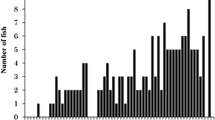Synopsis
The models developed here provide a precise quantitative description of the course of the thermal destruction experienced by fish during a slow heating experiment. However, a broader view of this work is that each of the abrupt transfer and slow heating techniques determines experimentally a functional relationship; the interdependence of these functional relationships is the actual focus of this study. In particular, it is shown that data from either type of experiment can be used to predict the observations from an experiment of the other type under certain assumptions.
Similar content being viewed by others
References cited
Becker, C.D. & R.G. Genoway. 1979. Evaluation of the critical thermal maximum for determining thermal tolerance of freshwater fish. Env. Biol. Fish. 4: 245–256.
Brett, J.R. 1944. Tempering versus acclimation in the planting of speckled trout. Trans. Amer. Fish. Sec. 70: 397–403.
Brett, J.R. 1946. Rate of gain of heat tolerance in goldfish. Carassius auratus. Univ. Toronto Studies, Biol. Ser. 53, Ontario Fish. Res. Lab. Publ. 64: 9–28.
Brett, J.R. 1952. Temperature tolerance in young Pacific salmon, genus Oncorhynchus. J. Fish. Res. Board Can. 9: 265–323.
Brett, J.R. 1956. Some principles in the thermal requirements of fishes. Quart. Rev. Biol. 31: 75–87.
Brown, H.W. 1976. Handbook of the effects of temperature on some North American fishes. American Electric Power Service Corporation, Canton. 524 pp.
Brown, M.E. 1957. The physiology of fishes. Vol 1— Metabolism. Vol 2 — Behavior. Academic Press, London.
Cocking, A.W. 1959. The effects of high temperatures on roach (Rutilus rutilus).II. The effects of temperature increasing at a known rate. J. Exp. Biol. 36: 217–226.
Coutant, C.C. 1972. Time-temperature relationships for thermal resistances of aquatic organisms, principally fish. Oak Ridge National Laboratory, Oak Ridge (ORNLEIS, 72–27). 100 pp.
Cox, D.K. 1974. Effects of three heating rates on the critical thermal maximum of bluegill. pp. 158–163. In: J.W. Gibbons & R.R. Sharitz (ed.) Thermal Ecology, CONF-730505, Technical Information Centre, Atomic Energy Commission, Springfield.
Doudoroff, P. 1942. Reactions of marine fishes to temperature changes. I. Experiments with Girella nigricans (Ayres). Biol. Bull. 83: 219–244.
Doudoroff, P. 1945. The resistance and acclimatization of marine fishes to temperature changes. II. Experiments with Fundulus and Atherinops. Biol. Bull. 88: 194–206.
Fry, F.E.J. 1947. Effects of the environment on animal activity. Univ. Toronto Studies, Biol. Ser. 55, Ontario Fish. Res. Lab. Publ. 68: 1–62.
Fry, F.E.J. 1967. Responses of vertebrate poikilotherms to temperature. pp. 375–409. In: A.H. Rose (ed.) Thermobiology, Academic Press, New York.
Fry, F.E.J., J.S. Hart & N.F. Walker. 1946. Lethal temperature relations for a sample of young speckled trout, Salvelinus fontinalis. Univ. Toronto Studies, Biol. Set. 54, Ontario Fish. Res. Lab. Publ. 66: 9–35.
Houston, A.H. 1982. Thermal effects upon fishes. Publication No. NRCC 18566, Environmental Secretariat, National Research Council of Canada. Ottawa. 200 pp.
Hutchinson, V.H. 1976. Factors influencing thermal tolerances of individual organisms. pp. 10–26. In: G.W. Esch & R.W. McFarlane (ed.) Thermal Ecology II, CONF-750425, Nat. Tech. Inf. Serv., Springfield.
Ihssen, P. 1971. The inheritance of thermal resistance in hybrids of Salvelinus fontinalis (Mitch.) and Salvelinus namaycush (Walb.). Ph.D. Thesis, University of Toronto, Toronto. 226 pp.
Jacobs, M.H. 1919. Acclimatization as a factor affecting the upper thermal death point of organisms. J. Exp. Zool. 27: 427–440.
Jaske, R.T., W.T. Templeton & C.C. Coutant. 1970. Methods for evaluating the effects of transient conditions in heavily loaded and extensively regulated streams. Chemical Engineering Progress, Symposium Series 107: 31–37.
Jobling, M. 1981. Temperature tolerance and the final preferendum — rapid methods for the assessment of optimum growth temperatures. J. Fish Biol. 19: 439–455.
Kilgour, D.M., R.W. McCauley & W. Kwain. 1985. Modeling the lethal effects of high temperature on fish. Can. J. Fish. Aquat. Sci. 42: 947–951.
McCauley, R.W. & F.P. Binkowski. 1982. Thermal tolerance of the alewife. Trans. Amer. Fish. Soc. 111: 389–391.
McFarlane, R.W., B.C. Moore & S.E. Williams. 1976. Thermal tolerance of stream cyprinid minnows. pp. 141–144. In: G.W. Esch & R.W. McFarlane (ed.) Thermal Ecology II, CONF-750425, Nat. Tech. Inf. Serv., Springfield.
Otto, R.G., M.A. Kitchell & J.O. Rice. 1976. Lethal and preferred temperatures of the alewife (Alosa pseudoharengus) in Lake Michigan. Trans. Amer. Fish. Soc. 105: 96–106.
Paladino, F.V., J.R. Spotila, J.P. Schubauer & K.T. Kowalski. 1980. The critical thermal maximum: a technique used to elucidate physiological stress and adaptation in fishes. Rev. Can. Biol. 39: 115–122.
Reynolds, W.W. & M.E. Casterlin. 1979. Behavioral thermal regulation and the ‘final preferendum’ paradigm. Amer. Zool. 19: 211–224.
Spigarelli, S.A., G.P. Romberg, W. Prepejchal & M.M. Thommes. 1974. Body temperature characteristics of fish at a thermal discharge on Lake Michigan, pp. 119–132. In: J.W. Gibbons & R.R. Sharitz (ed.) Thermal Ecology, CONF-730505, Technical Information Centre, Atomic Energy Commission, Springfield.
Stevens, E.D. & F.E.J. Fry. 1970. The rate of thermal exchange in a teleost Tilapia mossambica. Can. J. Zool. 48: 221–226.
Author information
Authors and Affiliations
Rights and permissions
About this article
Cite this article
Kilgour, D.M., McCauley, R.W. Reconciling the two methods of measuring upper lethal temperatures in fishes. Environ Biol Fish 17, 281–290 (1986). https://doi.org/10.1007/BF00001494
Received:
Accepted:
Issue Date:
DOI: https://doi.org/10.1007/BF00001494




